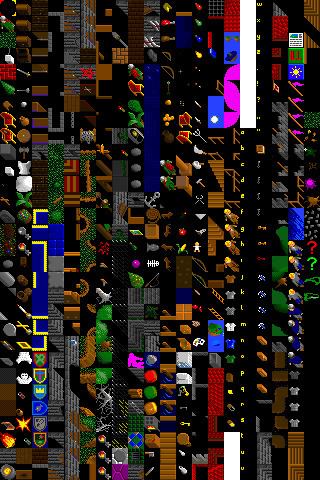 | ||
A tile-based video game is a type of video or video game where the playing area consists of small rectangular, square, parallelogram or hexagonal graphic images, referred to as tiles. The complete set of tiles available for use in a playing area is called a tileset. Tiles are laid out adjacent to one another in a grid; usually, some tiles are allowed to overlap, for example, when a tile representing a unit is overlaid onto a tile representing terrain. Tile-based games usually simulate a top-down or "2.5D" view of the playing area, and are almost always two-dimensional.
Contents
Tile-based games are not a distinct video game genre; rather, the term refers to the technology a game engine uses for its visual representation. For example, Ultima III is a role-playing video game and Civilization is a turn-based strategy game, but both use tile-based graphic engines. Tile-based engines allow developers to create large, complex gameworlds efficiently and with relatively few art assets.
Tile-based video games usually use a texture atlas for performance reasons. They also store metadata about the tiles, such as collision, damage, and entities, either with a 2-dimensional array mapping the tiles, or a second texture atlas mirroring the visual one but coding metadata by colour. This approach allows for simple, visual map data, letting level designers create entire worlds with a tile reference sheet and perhaps a text editor, a paint program, or a simple level editor (many older games included the editor in the game). Examples of tile-based game engine/IDEs include RPG Maker, Game Maker, Construct, Godot, and Tiled.
Variations include level data using "material tiles" that are procedurally transformed into the final tile graphics, and groupings of tiles as larger-scale "supertiles" or "chunks," allowing large tiled worlds to be constructed under heavy memory constraints. Ultima 7 uses a "tile," "chunk" and "superchunk" three-layer system to construct an enormous, detailed world within the PCs of the early 1990s.
History
The tile model was introduced by the Namco Galaxian arcade system board in 1979. The most common tile size used in video games was 8×8 pixels. A tilemap consisting of 8×8 tiles required 64 times less memory and processing time than a non-tiled framebuffer. Early video game consoles such as the Intellivision were designed to use tile-based graphics, since their games had to fit into video game cartridges as small as 4K in size, and all games on the platform were tile-based.
Early tile-based games shipped with pre-constructed levels or generated levels at game startup (for example, with SimCity and Civilization) or on the fly (as with Roguelike games).
The tile model became widely used in specific game genres such as platformers and role-playing video games, and reached its peak during the 8-bit and 16-bit eras of consoles, with games such as Mega Man (NES), The Legend of Zelda: A Link to the Past (SNES) and Shining Force (Mega Drive) being prime examples of tile-based games, producing a highly recognizable look and feel.
Most early tile-based games used a top-down perspective. The top-down perspective evolved to a simulated 45-degree angle, seen in 1994's Final Fantasy VI, allowing the player to see both the top and one side of objects, to give more sense of depth; this style dominated 8-bit and 16-bit console role-playing games. Ultimate Play The Game developed a series of video games in the 1980s that employed a tile-based isometric perspective. As computers advanced, isometric and dimetric perspectives began to predominate in tile-based games, using parallelogram-shaped tiles instead of square tiles. Notable titles include:
Hexagonal tile-based games have been limited for the most part to the strategy and wargaming genres. Notable examples include the Sega Genesis game Master of Monsters, SSI's Five Star series of wargames, the Age of Wonders series and Battle for Wesnoth.
Some entirely 3D games have been tile-based; one notable example is the Neverwinter Nights series from BioWare. Other games, like side-scrollers, are technically also tile-based (that is, the playing area is made up of graphic tiles), but are normally not referred to as such, for instance Lode Runner.
List of tile-based video games
Other examples of tile-based video games include:
